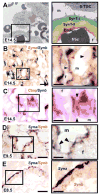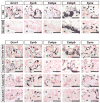Early patterning of the chorion leads to the trilaminar trophoblast cell structure in the placental labyrinth
- PMID: 18448564
- PMCID: PMC3159581
- DOI: 10.1242/dev.020099
Early patterning of the chorion leads to the trilaminar trophoblast cell structure in the placental labyrinth
Abstract
The labyrinth of the rodent placenta contains villi that are the site of nutrient exchange between mother and fetus. They are covered by three trophoblast cell types that separate the maternal blood sinusoids from fetal capillaries--a single mononuclear cell that is a subtype of trophoblast giant cell (sinusoidal or S-TGC) with endocrine function and two multinucleated syncytiotrophoblast layers, each resulting from cell-cell fusion, that function in nutrient transport. The developmental origins of these cell types have not previously been elucidated. We report here the discovery of cell-layer-restricted genes in the mid-gestation labyrinth (E12.5-14.5) including Ctsq in S-TGCs (also Hand1-positive), Syna in syncytiotrophoblast layer I (SynT-I), and Gcm1, Cebpa and Synb in syncytiotrophoblast layer II (SynT-II). These genes were also expressed in distinct layers in the chorion as early as E8.5, prior to villous formation. Specifically, Hand1 was expressed in apical cells lining maternal blood spaces (Ctsq is not expressed until E12.5), Syna in a layer immediately below, and Gcm1, Cebpa and Synb in basal cells in contact with the allantois. Cebpa and Synb were co-expressed with Gcm1 and were reduced in Gcm1 mutants. By contrast, Hand1 and Syna expression was unaltered in Gcm1 mutants, suggesting that Gcm1-positive cells are not required for the induction of the other chorion layers. These data indicate that the three differentiated trophoblast cell types in the labyrinth arise from distinct and autonomous precursors in the chorion that are patterned before morphogenesis begins.
Figures






Similar articles
-
The Hand1, Stra13 and Gcm1 transcription factors override FGF signaling to promote terminal differentiation of trophoblast stem cells.Dev Biol. 2004 Jul 1;271(1):26-37. doi: 10.1016/j.ydbio.2004.03.029. Dev Biol. 2004. PMID: 15196947
-
The glial cells missing-1 protein is essential for branching morphogenesis in the chorioallantoic placenta.Nat Genet. 2000 Jul;25(3):311-4. doi: 10.1038/77076. Nat Genet. 2000. PMID: 10888880
-
Early gene expression and morphogenesis of the murine chorioallantoic placenta in vivo and in vitro.Placenta. 2009 Jan;30(1):96-104. doi: 10.1016/j.placenta.2008.09.014. Epub 2008 Nov 12. Placenta. 2009. PMID: 19007985
-
The basal chorionic trophoblast cell layer: An emerging coordinator of placenta development.Bioessays. 2016 Mar;38(3):254-65. doi: 10.1002/bies.201500087. Epub 2016 Jan 18. Bioessays. 2016. PMID: 26778584 Review.
-
Transcription factors underlying the development and endocrine functions of the placenta.Recent Prog Horm Res. 2002;57:221-34. doi: 10.1210/rp.57.1.221. Recent Prog Horm Res. 2002. PMID: 12017545 Review.
Cited by
-
Resolving the gene expression maps of human first-trimester chorionic villi with spatial transcriptome.Front Cell Dev Biol. 2022 Dec 6;10:1060298. doi: 10.3389/fcell.2022.1060298. eCollection 2022. Front Cell Dev Biol. 2022. PMID: 36561369 Free PMC article.
-
Extracellular Matrix Influences Gene Expression and Differentiation of Mouse Trophoblast Stem Cells.Stem Cells Dev. 2023 Oct;32(19-20):622-637. doi: 10.1089/scd.2022.0290. Epub 2023 Aug 14. Stem Cells Dev. 2023. PMID: 37463089 Free PMC article.
-
Important aspects of placental-specific gene transfer.Theriogenology. 2014 Oct 15;82(7):1043-8. doi: 10.1016/j.theriogenology.2014.07.010. Epub 2014 Jul 15. Theriogenology. 2014. PMID: 25110063 Free PMC article.
-
Inactivation of maternal Hif-1α at mid-pregnancy causes placental defects and deficits in oxygen delivery to the fetal organs under hypoxic stress.Dev Biol. 2017 Feb 15;422(2):171-185. doi: 10.1016/j.ydbio.2016.12.013. Epub 2016 Dec 9. Dev Biol. 2017. PMID: 27940158 Free PMC article.
-
The Fgf/Erf/NCoR1/2 repressive axis controls trophoblast cell fate.Nat Commun. 2023 May 4;14(1):2559. doi: 10.1038/s41467-023-38101-8. Nat Commun. 2023. PMID: 37137875 Free PMC article.
References
-
- Anson-Cartwright L, Dawson K, Holmyard D, Fisher SJ, Lazzarini RA, Cross JC. The glial cells missing-1 protein is essential for branching morphogenesis in the chorioallantoic placenta. Nat Genet. 2000;25:311–314. - PubMed
-
- Basyuk E, Cross JC, Corbin J, Nakayama H, Hunter P, Nait-Oumesmar B, Lazzarini RA. Murine Gcm1 gene is expressed in a subset of placental trophoblast cells. Dev Dyn. 1999;214:303–311. - PubMed
-
- Beck F, Erler T, Russell A, James R. Expression of Cdx-2 in the mouse embryo and placenta: possible role in patterning of the extra-embryonic membranes. Dev Dyn. 1995;204:219–227. - PubMed
Publication types
MeSH terms
Substances
Grants and funding
LinkOut - more resources
Full Text Sources
Molecular Biology Databases

